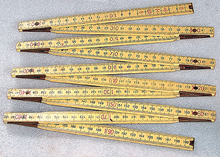
A zigzag is a pattern made up of small corners at variable angles, though constant within the zigzag, tracing a path between two parallel lines; it can be described as both jagged and fairly regular.
In geometry, this pattern is described as a skew apeirogon. From the point of view of symmetry, a regular zigzag can be generated from a simple motif like a line segment by repeated application of a glide reflection.
Although the origin of the word is unclear, its first printed appearances were in French-language books and ephemera of the late 17th century.[1]
Examples of zigzags
[edit]


- The trace of a triangle wave or a sawtooth wave is a zigzag.
- Pinking shears are designed to cut cloth or paper with a zigzag edge, to lessen fraying.[2]
- In sewing, a zigzag stitch is a machine stitch in a zigzag pattern.[3]
- The zigzag arch is an architectural embellishment used in Islamic, Byzantine, Norman and Romanesque architecture.[4][5]
- In seismology, earthquakes recorded in a "zigzag line" form by using seismograph.[6]
See also
[edit]References
[edit]- ^ Liberman, Anatoly (2009). Word Origins...And How We Know Them: Etymology for Everyone. Oxford University Press, USA. ISBN 978-0-19-538707-0.
- ^ Shepler, Missy; Brent, Rebecca (2011). The Complete Idiot's Guide to Sewing. Penguin. p. 84. ISBN 978-1-101-51368-2.
- ^ Gardiner, Wendy; Knight, Lorna (2011). The Sewing Machine Accessory Bible: Get the Most Out of Your Machine---From Using Basic Feet to Mastering Specialty Feet. Macmillan. pp. 34–35. ISBN 978-0-312-67658-2.
- ^ Allen, Terry (1986). "4". A Classical Revival in Islamic Architecture. Wiesbaden.
{{cite book}}: CS1 maint: location missing publisher (link) - ^ Allen, Terry (2008). Pisa and the Dome of the Rock (electronic publication) (2nd ed.). Occidental, California: Solipsist Press. ISBN 978-0-944940-08-2. Retrieved January 28, 2012.
- ^ "Seismograph - What is a seismograph?". SMS-Tsunami-Warning.com. Retrieved 8 January 2023.
Bibliography
[edit]- Wedgwood, Hensleigh (1855). "On Roots mutually connected by reference to the term Zig-zag". Transactions of the Philological Society (2).
Well, that’s interesting to know that Psilotum nudum are known as whisk ferns. Psilotum nudum is the commoner species of the two. While the P. flaccidum is a rare species and is found in the tropical islands. Both the species are usually epiphytic in habit and grow upon tree ferns. These species may also be terrestrial and grow in humus or in the crevices of the rocks.
View the detailed Guide of Psilotum nudum: Detailed Study Of Psilotum Nudum (Whisk Fern), Classification, Anatomy, Reproduction